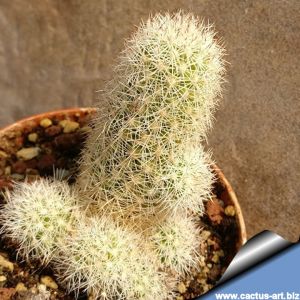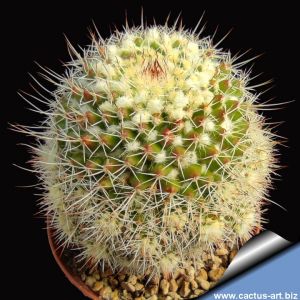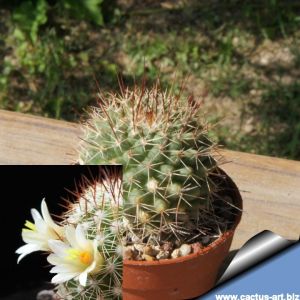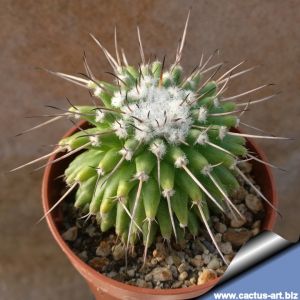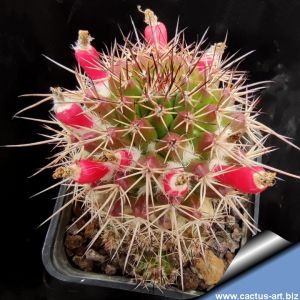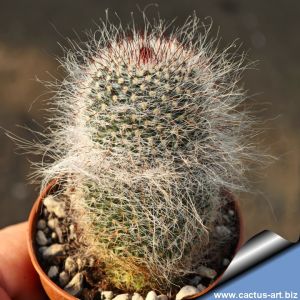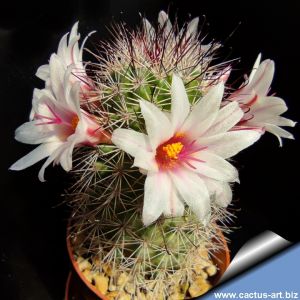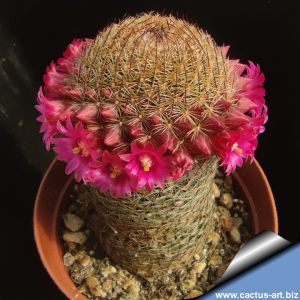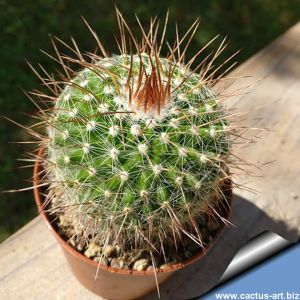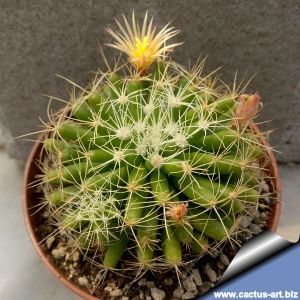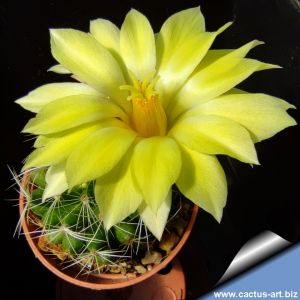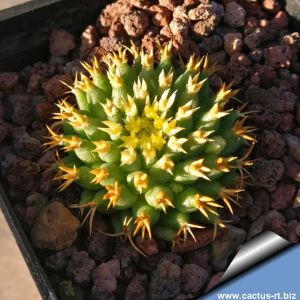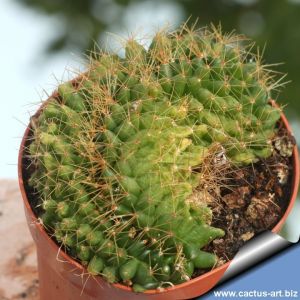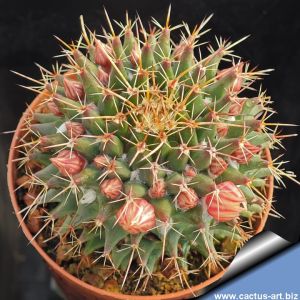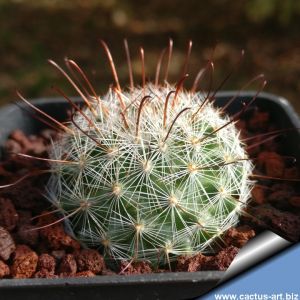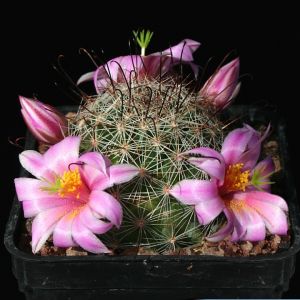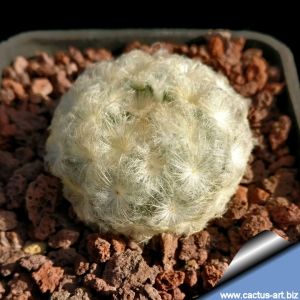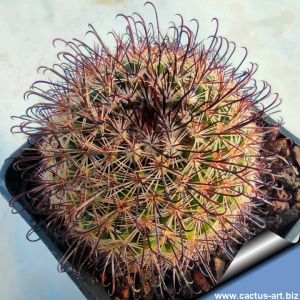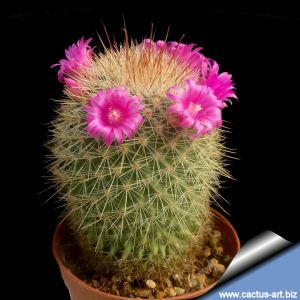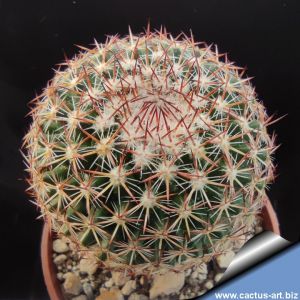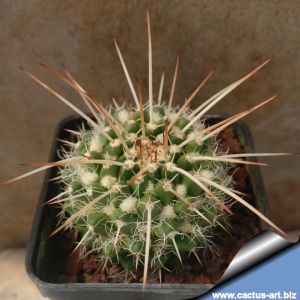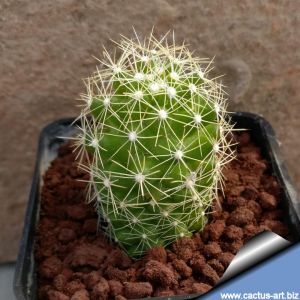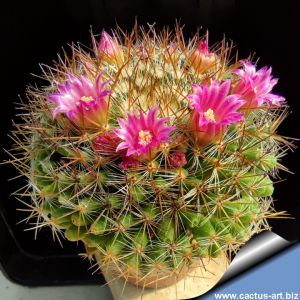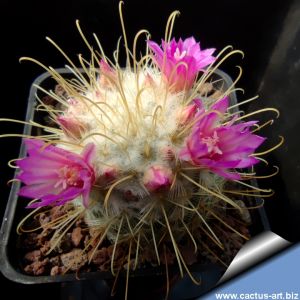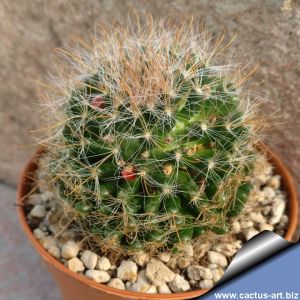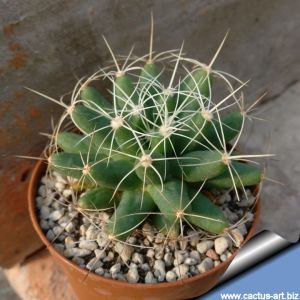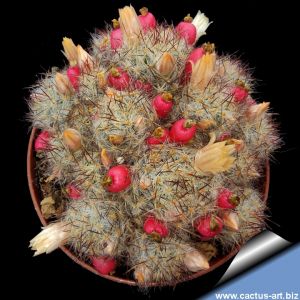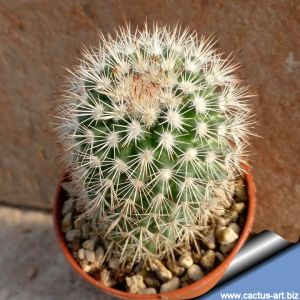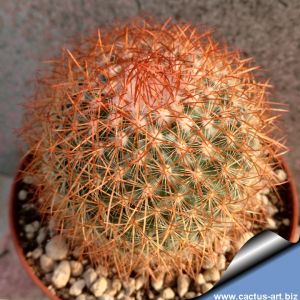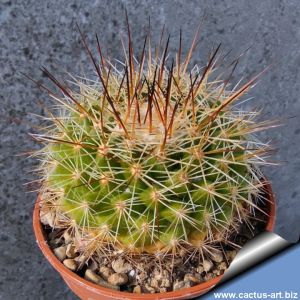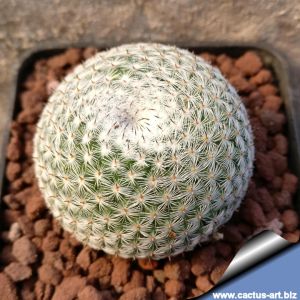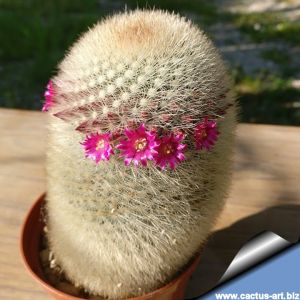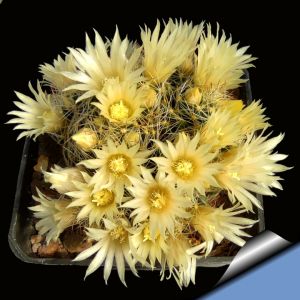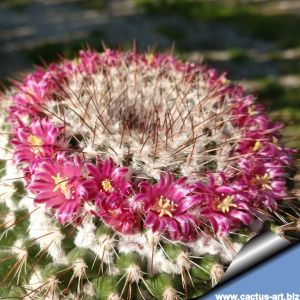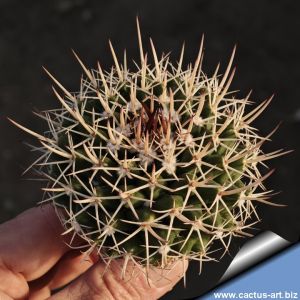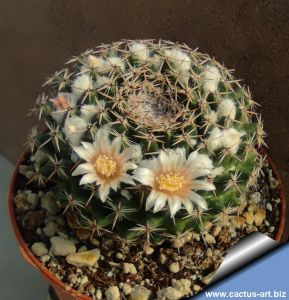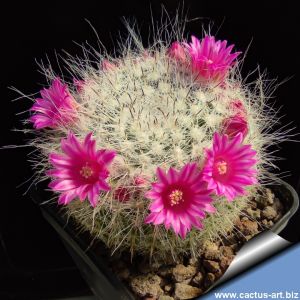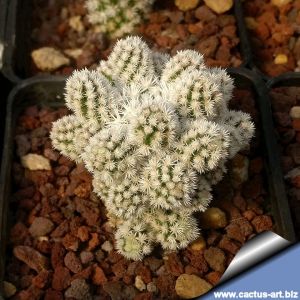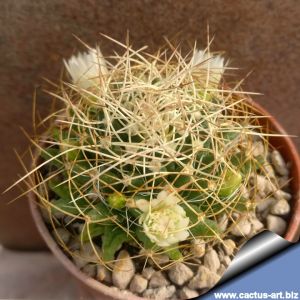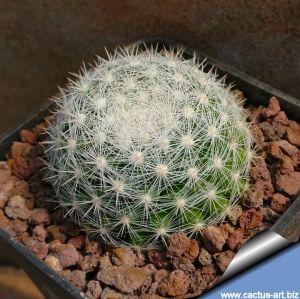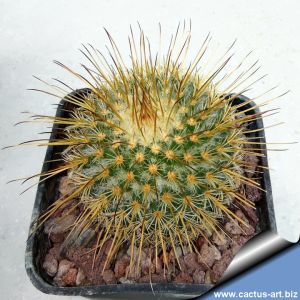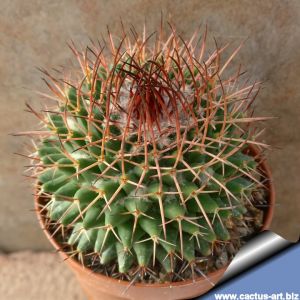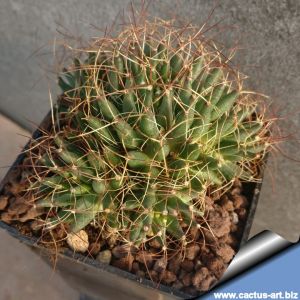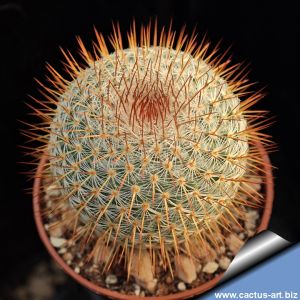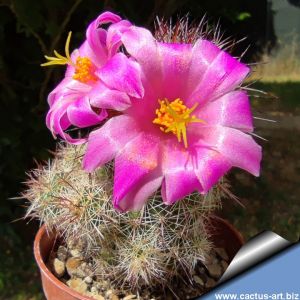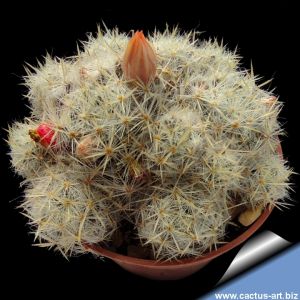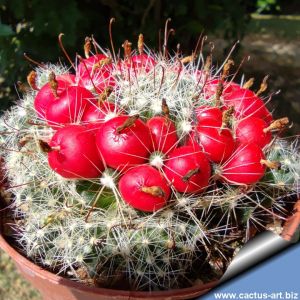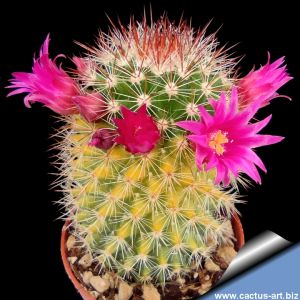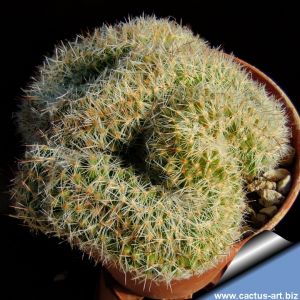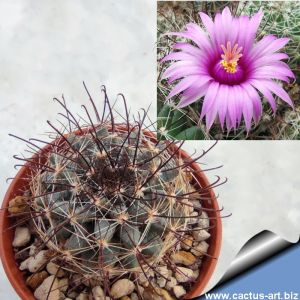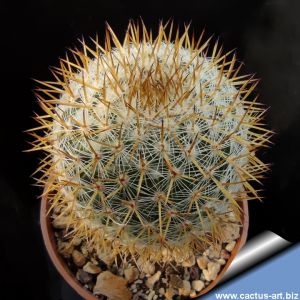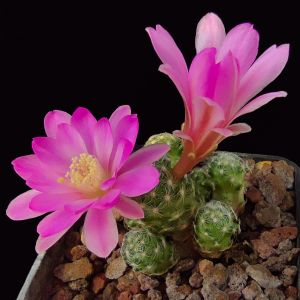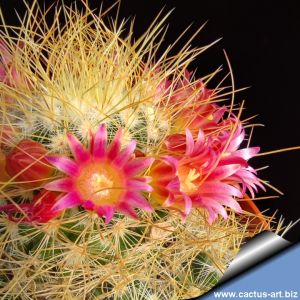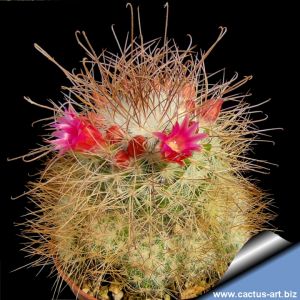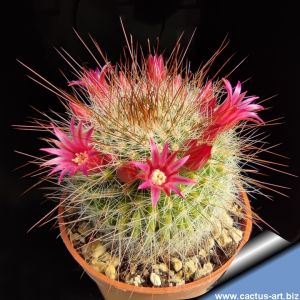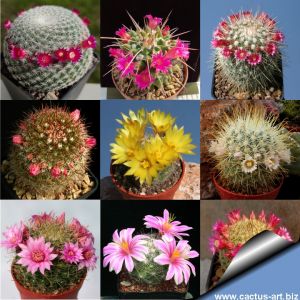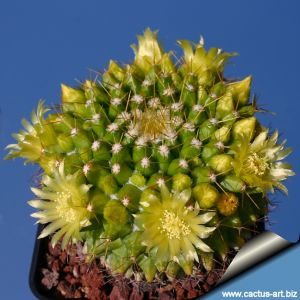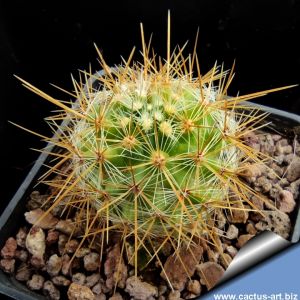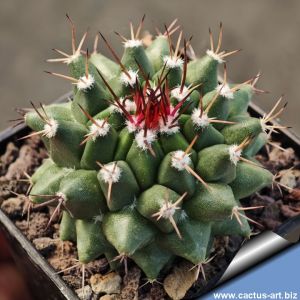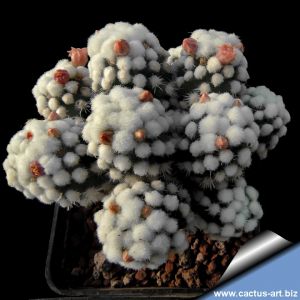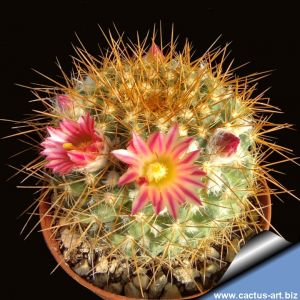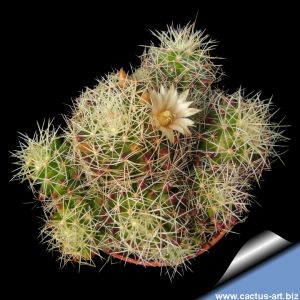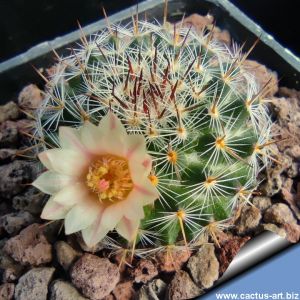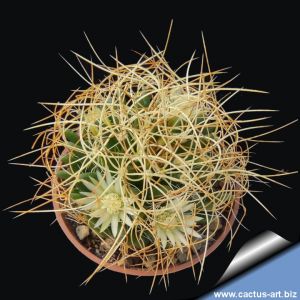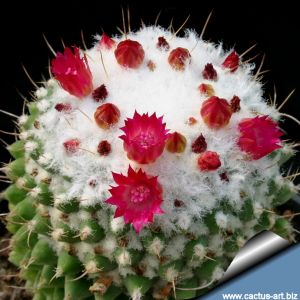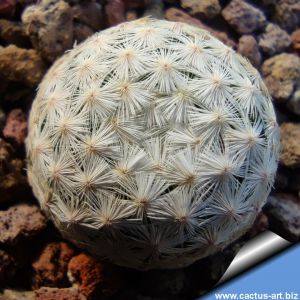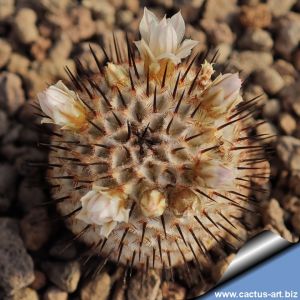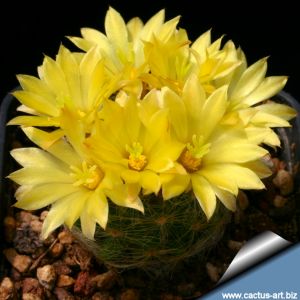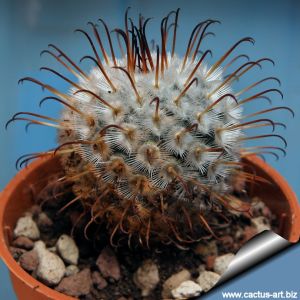-
1
Fusti sottili a forma di dita, grigio-verde chiaro che generano rapidamente polloni laterali creando densi gruppi. Le areole presentano 10–15 spine radiali bianco-beige e 1–3 centrali, a punta scura. I fiori sono rosso-porpora o carminio.
-
2
Mammillaria nejapensis cv. multiprolifera produces in a short time thousands of tiny, tightly pached stems all around its base.
-
3
Mammillaria multidigitata is endemic to San Pedro Nolasco Island in Mexico, where it growson steep slopes. From spring to early summer it sprouts white to cream colored flowers with yellow-green stigma and orange pollen.
-
4
La Mammillaria sempervivi f. monstrosa si riconosce per la singola spina centrale lunga in ogni areola. Cresce in gruppi piatti, con lanuggine bianca tra le areole, rendendola piacevole da osservare e coltivare.
-
5
Fiori bianchi con venature centrali rosa più intense, una spina centrale e circa 7 spine radiali. Ramifica abbondantemente dalla base, formando cespi che possono raggiungere i 40 cm di larghezza.
-
6
La Mammillaria hahniana f. elongata si distingue per il fusto che, con il tempo, assume una forma brevemente colonnare. La pianta, ricoperta di lunghe setole bianche, è di grande bellezza.
-
7
-
8
-
9
Mammillaria variaculeata is a clumping cactus forking dichotomously. It has rather uninteresting short spines when young, before making a fierce and very showy mature dark brown spination. However the species comprises plants with variable spine length.
-
10
-
11
Corpo tondo con lunghi tubercoli morbidi e sottili spine color crema. Il vero punto di forza sono i fiori enormi, di un giallo intenso e luminoso, che creano un contrasto spettacolare e di grande impatto visivo.
-
12
Very nice form with 4 (-6) very short orangish radial spines. The younger spines are yellow and very attractive).
-
13
-
14
Cresce nello stesso ambiente di Ferocactus echidne REP1139A e Mammillaria priessnitzii REP1134.
-
15
-
16
-
17
-
18
-
19
-
20
-
21
Una Mammillaria sorprendente! La lunghezza delle spine varia a seconda dell'esposizione soloare e dell'età, creando esemplari sempre diversi. Cresce formando grandi gruppi compatti grazie alla divisione dicotomica.
-
22
-
23
Fusto globoso e leggermente appiattito, fino a 4 cm in altezza e 8 cm di diametro, ornato da spine centrali che variano dal giallo-ambra al bruno-rossastro; fiori di colore carminio.
-
24
Forma selezionata di Mammillaria bombycina, riconoscibile per le spine centrali giallo-crema uniformi, sempre uncinate ma prive delle tipiche punte rosso-scure presenti nella forma standard.
-
25
-
26
-
27
Autofertile, fiorisce ripetutamente per tutta la buona stagione e produce numerose bacche rosse commestibili senza richiedere fecondazione. Di semplice coltivazione.
-
28
Mammillaria tayloriorum (Mammillaria tayloriana) is endemic to the island of San Pedro Nolasco Island in the Gulf of California (Sonora, mexico) It grows together with Mammillaria multidigitata, Echinocereus websterianus and Pachycereus pringlei.
-
29
La var. ruberrima rappresenta una forma particolarmente distintiva della specie Mammillaria rhodantha. Il termine "ruberrima", derivante dal latino, significa "molto rossa" o "del colore del rubino", e questo tratto è proprio ciò che definisce la varietà.
-
30
Mammillaria rhodantha è un cactus brevemente colonnare che, con l’età, si divide dicotomicamente formando grossi cespi. Le spine sono il tratto più variabile; nella forma scura presenta centrali rosso-bruno scuro.
-
31
-
32
Fusti globosi con apice depresso, ricoperti da spine corte e fitte e da molta lana tra i tubercoli, tanto da rendere invisibile la superficie del fusto. I piccoli fiori, disposti a corona, variano dal carminio al rosa-violaceo.
-
33
-
34
Fusto minuscolo, tuberoso alla base, di forma globose o ovoidale. Spine sottili e pubescenti, giallo-chiare alla base, bianche nella parte mediana, brune o ambra in punta. Specie a fioritura invernale: produce fiori verde-bianchi perfino da giovane.
-
35
Cactus rotondo e simmetrico, con spine corte e dure. Piccoli fiori viola disposti in cerchio attorno all’apice del fusto.
-
36
La forma ‘horrida’ si distingue per la sua armatura di spine imponenti—più spesse, rigide e aggressive di quelle della specie tipo. Il portamento basso e la crescita rapida la rendono subito scenografica. Con gli anni forma un maestoso cuscino emisferico.
-
37
-
38
Mammillaria woodsii, fusto bianco con tubercoli sormontati da spine radiali bianche e centrali bruno-nerastre, avvolti in una fitta lanuggine bianca. I fiori creano una corona rosso-purpurea in primavera ed estate. Bellissima!
-
39
Dwarf form of ARIZONA SNOWCAP
-
40
Mammillaria camptotricha (Dolichothele camptotricha) - Pianta che forma cespi appiattiti di fusti con tubercoli allungati e spine sottili e attorcigliate che avvolgono il corpo (da cui il nome "Cactus Nido d’Uccello").
-
41
Chiamata comunemente “Snowball”, Mammilloydia candida si distingue per le spine bianchissime e talmente dense da coprire completamente il fusto. È imparentata con il genere Mammillaria, ma generalmente classificata come genere separato.
-
42
Very pretty plants with long pale amber to reddish central spines, pink flowers.
-
43
Mammillaria carnea is a rather robust cactus species. The plant typically has 4-sided angular tubercles with yellow, woolly axils and only 4 reddish radial spines. It will reward the skilled growers with ring of fine flesh-pink flowers circling the crown.
-
44
Pianta che forma cespi appiattiti di fusti con tubercoli allungati e spine sottili e attorcigliate che avvolgono il corpo (da cui il nome "Cactus Nido d’Uccello"). Questa forma ha spine color crema opaco-marrone. Ideale per vasi bassi.
-
45
Delicata forma variegata con base dei tubercoli giallo crema. La variegatura si accentua con luce filtrata, mentre in pieno sole la pianta tende a rinverdire.
-
46
Mammillaria conspicua si distingue dalle altre forme del complesso Mammillaria haageana per il portamento spesso solitario e per i fusti più grandi, fino a 10–11 cm di diametro. Ogni testa è circondata da un anello completo di fiori stellati rosa magenta.
-
47
Mammillaria occidentalis also known as Mammillaria mazatlanensis var. occidentalis is a clumping species which has large pink flowers in summer. The flowers are slightly scented. These can be followed by red fruits.
-
48
Piccolissima Mammillaria, capace di sviluppare in breve tempo fitti cuscini composti da tanti minuscoli fusti avvolti in spine avorio. Fiorisce abbondantemente con fiori gialli e genera bacche rosse commestibili senza bisogno di impollinazione.
-
49
Mammillaria oteroi clusters freely and the offsets detach readily. It has some of the roundest fruits among mammillarias. The fruits are globose, 7-8 mm long, bright red. Flowers are pale yellowish green with muddy cerise midstripe.
-
50
Variegated plants have sectors, patches or stripes with two or more colours. Plants with variegated body are highly prized. Very variable.
-
51
-
52
Tutte le spine centrali sono uncinate e orientate a sinistra in senso antiorario, formando un disegno geometrico ipnotico. A completare questo capolavoro, fiori eccezionalmente grandi, di un rosa magenta. Assolutamente straordinaria!
-
53
-
54
Meraviglia in miniatura con corpi globosi ricoperti da spine a pettine argentee e aderenti. Fiori rosa fluo più grandi del cactus stesso! Radice a fittone carnosa. Crescita lentissima, vero trofeo per collezionisti.
-
55
Pretty with long twisted yellow spines, magnificent!
-
56
Le spine lunghe, sottili e contoerte, conferiscono alla pianta un aspetto morbido e decorativo. La forma delle spine è un tratto distintivo rispetto ad altre varianti della specie.
-
57
-
58
Mix di Mammillarie (varie specie, ibridi e cultivar da seme). Ogni esemplare è esclusivo,
caratterizzato da forme, spine e fiori dai colori diversi.
-
59
-
60
Pretty with long yellowish spines.
-
61
Corpo appiattito, inizialmente solitario, poi a formare colonie. I tubercoli piramidali seguono spirali regolari. Produce fiori rosa o tendenti al rosso.
-
62
-
63
Selected form with very long yellow spines, pink flowers, very beautiful species!
-
64
Areole lanose, ascelle colme di fitta lana bianca e fitte setole bianche allungate. Spine imponenti, color giallo-arancio fino al rosso. Pianta poco diffusa in coltivazione, di grande fascino.
-
65
-
66
Mammillaria chionocephala is an attractive globose pincushion cactus with white to rose-red flowers, in a circle near the summit.
-
67
Long twisted cream colored spines form an intricate nest-like pattern on top.
-
68
Cultivar particolare e molto attraente, caratterizzata da totale o quasi totale assenza di spine. I tubercoli lunghi sono coronati da lana bianchissima, mentre i fiori sono di un vivido rosa profondo. L’effetto visivo è raffinato ed elegante .
-
69
Minuscolo cactus dalla forma di una pallina da golf, ricoperto da spine bianche fitte e appressate. Produce fiori sorprendentemente grandi per una Mammillaria, rosa-viola e di grande impatto visivo.
-
70
La M. andersoniana è un cactus minuscolo e affascinante, che si differenzia dalla specie principale per la taglia più piccola, la crescita più lenta e le spine centrali diritte (non a uncino). Si ritiene sia una delle Mammilla più belle!
-
71
Spine morbide, biancastre. Fiori gialli di dimensioni notevoli e profumati al limone. Cresce in associazione con Pilosocereus palmeri, Mammillaria candida, Echinocereus blanckii e Ritterocereus pruinosus. Una pianta dal fascino delicato.
-
72
Da avere assolutamente! Cactus nano con spine radiali bianche come neve e centrali uncinate color mogano. Quando fiorisce, esplode in tonalità rosa. Un gioiello che completa qualsiasi raccolta di piante rare.

